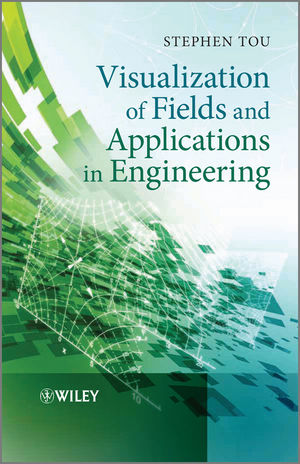Visualization of Fields and Applications in EngineeringISBN: 978-0-470-97397-4
Hardcover
384 pages
April 2011
 |
||||||
Preface ix
1 Introduction 1
1.1 A General View 1
1.2 Historical Development and Progress in Visual Science 3
1.3 Scientific Visualization Philosophy, Techniques and Challenges 7
2 Field Descriptions and Kinematics 11
2.1 Lagrangian/Eulerian Description and Transformation 11
2.2 Curvilinear Coordinates 15
2.2.1 Polar Coordinate 24
2.2.2 Streamline (Flux Line) Coordinates 29
2.2.3 Potential-Stream Function Coordinates 43
2.3 Field Kinematics and Visual Attributes 49
2.3.1 Field Line Trajectory 49
2.3.2 Field Line Integral Curves 50
2.3.3 Field Lines, Material Lines and Path Lines 54
2.3.4 Streamlines (Flux Lines) 56
3 Field Model, Representation and Visualization 63
3.1 Field Models and Concepts 63
3.2 Scalar Fields and Representation 65
3.3 Vector Fields and Representation 68
3.4 Vector Icons and Classifications 69
3.4.1 Classification Based on Domain Configurations 70
3.4.2 Classification Based on Information Levels 70
3.4.3 Classification Based on Topological Skeleton 71
3.5 Scalar Potential 71
3.6 Vector Potential 74
3.7 Vector Field Specification 77
3.7.1 Helmholtz’s Theorem 77
3.8 Tensor Contraction and Transport Process Visualization 79
3.8.1 Mechanical Energy Function and Heat function 80
3.8.2 Strain Energy Trajectory and Strain Function 84
3.9 Multiple Fields 85
4 Complex Analysis and Complex Potentials 97
4.1 Complex Variables/Functions and Applications 97
4.2 Complex Analysis and Cauchy–Riemann Equation 100
4.3 Differentiation of Complex Function 101
4.4 Integration of Complex Functions 104
4.5 Visualization of Complex Potentials 107
4.5.1 Trajectory Method 107
4.5.2 Method of Curvilinear Squares 108
4.5.3 Transfer Characteristics and Field Property Evaluation 111
4.6 Example 4.1a Visualization of Heat and Fluid Transport in a Corner 114
5 Field Mapping and Applications 127
5.1 Introduction 127
5.2 Mapping of Euclidean Geometry 129
5.2.1 Congruent Mapping 129
5.2.2 Similitude Mapping 131
5.2.3 Affine Mapping 132
5.3 Inversion Mapping 133
5.3.1 Circle Inversion 134
5.4 Mapping with Complex Functions 135
5.5 Conformal Mapping and Applications 137
5.6 Hodograph Method and Mapping 147
5.6.1 Conjugate Hodograph 148
5.6.2 Hodograph 149
5.7 Hodograph Representations and Applications 149
5.7.1 Straight Boundaries 156
5.7.2 Free Surface 158
5.7.3 Special Field Patterns 160
5.7.4 Projectile Trajectory in Constant Force Fields 163
5.7.5 Motion Trajectory in Central Force Fields 169
5.7.6 Trajectory of Charged Particles in Uniform Magnetic Fields 179
5.8 Example 4.1b Mapping of Field Patterns and Image Warping 183
6 Tensor Representation, Contraction and Visualization 199
6.1 Introduction 199
6.2 Development of Tensor Visualization Techniques 200
6.2.1 Mohr’s Circle 200
6.2.2 Tensor Field Line Trajectories (Lines of Principal Stress) 200
6.2.3 Isochromatics 201
6.2.4 Isoclines 201
6.2.5 Stress Trajectories 201
6.2.6 Slip Lines 201
6.2.7 Isopachs 201
6.3 Tensor Description and Representation 201
6.3.1 Tensor Icons and Classification 204
6.4 Tensor Decomposition and Tensor Rank Reduction 204
6.4.1 Strain Tensor and Stress Tensor 206
6.4.2 Rotation Tensor 207
6.4.3 Rate of Strain Tensor and Viscous Stress Tensor 208
6.4.4 Vorticity Tensor 210
6.4.5 Tensor Contractions: Tensor Vector on a Reference Plane 213
6.4.6 Tensor Contractions: Tensor Vector at a Point 214
6.5 Visualization of Symmetric Tensors 214
6.5.1 Tensor Invariants 214
6.5.2 Tensor Transformation 217
6.5.3 Principal States and Eigenanalysis 217
6.5.4 Hybrid Method of Tensor Visualization 227
6.6 Visualization of Antisymmetric Tensors 228
6.6.1 Vorticity Concepts and Dynamics 228
6.6.2 Forced Vortex 232
6.6.3 Free Vortex 237
6.6.4 Vortices Transport and Vorticity Function 240
6.7 Example: 4.1c Convective Momentum Flux Tensor Visualization 242
7 Critical Point Topology, Classification and Visualization 249
7.1 Introduction 249
7.2 Complex Analysis of Critical Point 251
7.3 Critical Point Theory and Classification 257
7.3.1 Symmetric Tensor: [∇V] = [∇V]T ;Im1 = Im2 = 0 261
7.3.2 Antisymmetric Tensor: τii = 0, i = j;τij = −τji, i _= j 262
7.3.3 Asymmetric Tensor 262
7.4 Example 4.1d Critical Point Topology 263
7.5 Singular Point Visualization and Mapping 265
7.6 Example 7.1 Mapping of a Point Source 266
8 Engineering Application Examples 273
8.1 Example 8.1: Torsion of a Square Beam 273
8.2 Example 8.2: Bending of a Cantilever Beam Subject to a Point Load 302
8.3 Example 8.3: Squeezing Flow and Vorticity Transport 323
8.4 Example 8.4: Groundwater Flows in an Anisotropic
Porous Medium 345
References 365
Index 369



